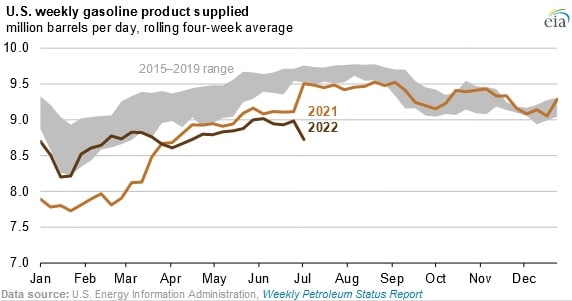U.S. Gasoline Consumption for The Second Quarter of 2022 Lower Year-On-Year: EIA

The amount of gasoline expended in the U.S. during the second quarter of 2022 and early July, has been lower than the same period in 2021, according to the U.S. Energy Information Administration’s latest Weekly Petroleum Status Report. The Petroleum Supply Monthly validates the trend and reports that U.S. gasoline consumption in April averaged 8.8 million barrels per day, down 0.4 percent compared to April 2021.
The decline in U.S. gasoline consumption can be attributed to a number of factors, including; the volume of travel, non-farm employment, vehicle fuel efficiency and gasoline prices. Generally, an increase in travel and non-farm employment leads to higher gas consumption, whilst enhancements in vehicle efficiency and alleviated gasoline prices contribute to lower gasoline consumption.
The U.S. Department of Transportation analysis reports that 1.6 percent more vehicle miles travelled during April 2022, compared to April 2021. Despite the year-on-year rise, increased fuel efficiency in vehicles has led drivers to travel a greater number of miles using less gasoline, offsetting the impact of increased travel. The U.S. Energy Information Administration estimated that vehicle efficiency increased in the U.S. by an average of 2 percent more miles per gallon in April 2022, than for the same period in 2021. This supports the claim that heightened efficacy could have compensated increased travel and led to an altogether reduction in gasoline consumption year-on-year. The U.S. average of miles per gallon has risen from 21.3 million per gallon in 2007 to an estimated 24.4 miles per gallon in the second quarter of 2022.
Moreover, alleviated gasoline prices may have resulted in less travel, however historically they have had an insignificant effect on consumption in the short term. The EIA projects that if gasoline prices double over a given period, then consumption would decline by 2-4 percent over the same period. However, as it stands there is no evidence to substantiate this prediction.
EnerKnol Pulses like this one are powered by the EnerKnol Platform—the first comprehensive database for real-time energy policy tracking. Sign up for a free trial below for access to key regulatory data and deep industry insights across the energy spectrum.
ACCESS FREE TRIAL


